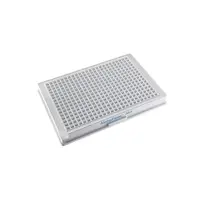
AlphaLISA Human IgG1 Detection Kit, 100 Assay Points






The AlphaLISA® IgG1 Detection Kit is designed for the quantitative determination of human IgG1 in serum, buffered solution, or cell culture medium using a homogeneous (no wash steps, no separation steps) assay.
This kit is a replacement for AL307.
For research use only. Not for use in diagnostic procedures. All products to be used in accordance with applicable laws and regulations including without limitation, consumption & disposal requirements under European REACH regulations (EC 1907/2006).
Product information
Overview
Immunoglobulin G1 (IgG1) belongs to the immunoglobulin antibody family and is the most abundant IgG subclass. IgG molecules are created and released by plasma B cells and represent an important mediated antibody response against viral pathogens by binding to soluble proteins and membrane protein antigens via variable domain and concomitantly activating effector mechanisms of the innate immune system. IgG1 can bind to C1q, causing complement-dependent cytotoxicity (CDC), and can bind to each of the different Fc receptors resulting in antibody-dependent cell-mediated cytotoxicity (ADCC). Increased IgG1 levels have been associated with inflammatory or autoimmune diseases that involve the central nervous system and IgG1 deficiencies are associated with a weakened immune system and increased susceptibility of infection.
Formats
- Our 100 assay point kit allows you to run 100 wells in 96-well format, using a 100 µL reaction volume (10 µL of sample).
- Our 500 assay point kit allows you to run 500 wells in 96-well or 384-well format, using a 50 µL reaction volume (5 µL of sample).
- Our 5,000 assay point kit allows you to run 5,000 wells in 96-well or 384-well format, using a 50 µL reaction volume (5 µL of sample).
Features
- No-wash steps, no separation steps
- ELISA alternative technology
- Sensitive detection
- Broad sample compatibility
- Small sample volume
- Results in less than 3 hours
- Half the time of an ELISA assay
AlphaLISA technology allows the detection of molecules of interest in a no-wash, highly sensitive, quantitative assay. In an AlphaLISA assay, a biotinylated anti-analyte antibody binds to the Streptavidin-coated Donor beads while another anti-analyte antibody is conjugated to AlphaLISA Acceptor beads. In the presence of the analyte, the beads come into close proximity. The excitation of the Donor beads causes the release of singlet oxygen molecules that triggers a cascade of energy transfer in the Acceptor beads, resulting in a sharp peak of light emission at 615 nm.
Specifications
| Application |
Protein Detection
|
|---|---|
| Assay Technology |
Alpha
|
| Automation Compatible |
Yes
|
| Brand |
AlphaLISA
|
| Detection Method |
Alpha
|
| Experimental Type |
In vitro
|
| Shipping Conditions |
Shipped in Blue Ice
|
| Target Species |
Human
|
| Unit Size |
100 Assay Points
|
Video gallery


Resources
With over 200 different types of cancer, management relies on a variety of techniques such as chemotherapy, radiotherapy, and...

SDS, COAs, Manuals and more
Are you looking for technical documents for this product. We have housed them in a dedicated section., click on the links below to explore.


How can we help you?
We are here to answer your questions.



































